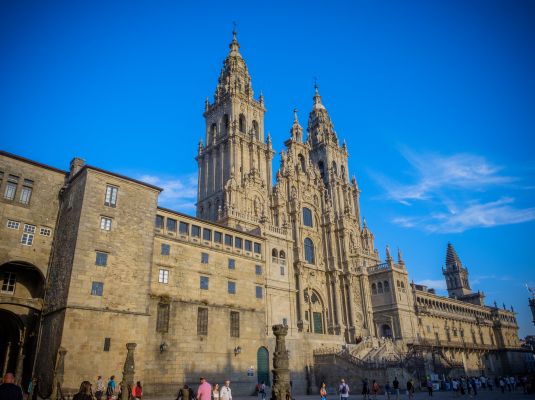IT may not appear so according to the official calendar, but 2022 is extra special for pilgrims making the journey to Santiago de Compostela after the Pope extended the Jacobean Year because of the pandemic.
The Xacobeo Year (also known as Jacobean Year or Jubilee Year) only occurs when July 25, the Festival of Saint James, falls on a Sunday.
This usually happens once every five or six years, but the wait can also last as long as eleven years, as was the case in 2021.
The holiday celebrates St. James, (or Santiago), the patron saint of Spain and one of Jesus’s apostles, whose remains are said to be held in the Santiago de Compostela Cathedral.

Pope Callixtus established the Xacobeo Year in 1126, and declared that those who make the pilgrimage to the cathedral anytime during that year would be relieved of their sins.
For the first time since its inception, this window will be extended across two years (2021 and 2022) due to restrictions caused by the pandemic, after the Pope gave special permission for it to be extended.
The weeks leading up to July 25 mark the height of festivities, which are held regardless of whether or not it is a Xacobeo year.

Celebrations highlight Galician culture and include fireworks, traditional dancing and music, and often include a visit from a member of the royal family.
During a Xacobeo Year, events also occur throughout the rest of the year to mark the occasion. Spain’s official tourism website has compiled a calendar with all the events to take place in 2021 and 2022.
The wide range of happenings are detailed HERE and include multiple music festivals, art exhibitions about the past and future of Galicia, and the World Parkour Championships, to name a few.

Those hoping for a complete pilgrimage experience can also embark on a walk along one of the routes of the Camino de Santiago, which extends over 500 miles from southern France to Santiago de Compostela.
Events will also be held along these routes, including concerts, art exhibitions, films, and educational activities.

The extent of the celebrations match the religious significance that St. James holds in Spain and across Europe, as his tomb is regarded as one of the continent’s most important religious sites. James, who is said to have visited Spain to spread the Gospel, was the first apostle of Jesus to be martyred.
Although it is believed that he died in Jerusalem, legend says that his tomb was placed in the ocean and sailed across the Mediterranean, ending up on the northwest coast of Spain.
There, his followers carried him inland to Compostela where he was buried.
His presence was then forgotten until around 800 years later, when a hermit discovered a burial site that contained St. James’ relics. The remains were quickly declared to be those of St. James by a local bishop.
King Alfonso II soon traveled from Oviedo to visit the site, becoming the first pilgrim to do so.
Although some researchers doubt that the remains in the tomb are those of St. James, this has not diminished the Xacobeo Year celebrations.

In a normal year, you can expect to see tens of thousands of people travelling to the cathedral, and many have continued to make the journey even during the pandemic.
READ MORE:
- Looking for an adventure in 2022? Here are 12 epic walks to take in Spain
- Escape to Arcadia with a week in Asturias
- 10 cities in Spain where you will find the best free tapas scene
Click here to read more Olive Press Travel News from The Olive Press.








